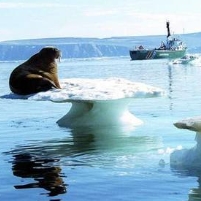NASA Satellite Reveals Dramatic Thinning of Arctic Ice
Saturday, July 11, 2009
 Arctic wlarus on thin ice (photo: Greenpeace)
Arctic wlarus on thin ice (photo: Greenpeace)
Imagine if Alaska, the largest state in the union, completely disappeared from the earth. That’s roughly what happened to an enormous amount of ice in the Arctic over just four years, NASA scientists concluded, after conducting the first comprehensive study of ice thickness and volume around the North Pole. From 2004 to 2008, as a result of global warming, the Arctic lost 595,000 square miles of ice, about the size of the nation’s five most populous states—California, Texas, New York, Florida and Illinois—combined.
Just as important as the size of lost ice was the type that melted away, scientists point out. There are two types of ice in the Arctic: thicker “multi-year ice,” which remains frozen from year to year; and thinner, seasonal ice that melts each summer. Most of what vanished over the four-year period was older ice, causing a dramatic reversal in the frozen composition of the Arctic. In 2003, 62% of the Arctic’s total ice volume was stored in multi-year ice, with 38% consisting of first-year seasonal ice. By 2008, 68% was first-year ice, with only 32% older ice left.
Ron Kwok of the Jet Propulsion Laboratory in Pasadena, CA, who led the research study that utilized data from NASA’s Ice, Cloud and land Elevation Satellite, noted it may just be a matter of time before the Arctic loses all of its ice during part of the year. “Our data will help scientists better understand how fast the volume of Arctic ice is decreasing and how soon we might see a nearly ice-free Arctic in the summer.”
-Noel Brinkerhoff
New NASA Satellite Survey Reveals Dramatic Arctic Sea Ice Thinning (NASA press release)
- Top Stories
- Unusual News
- Where is the Money Going?
- Controversies
- U.S. and the World
- Appointments and Resignations
- Latest News
- Musk and Trump Fire Members of Congress
- Trump Calls for Violent Street Demonstrations Against Himself
- Trump Changes Name of Republican Party
- The 2024 Election By the Numbers
- Bashar al-Assad—The Fall of a Rabid AntiSemite






Comments